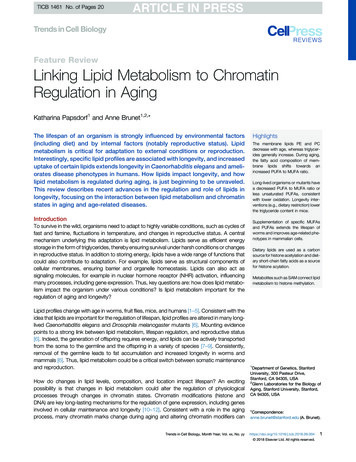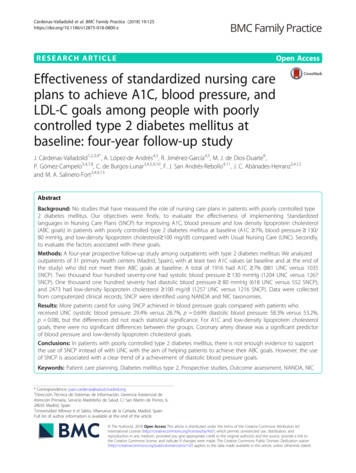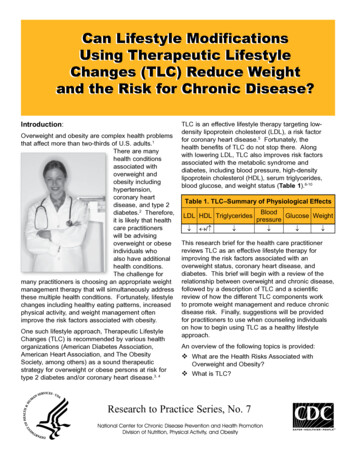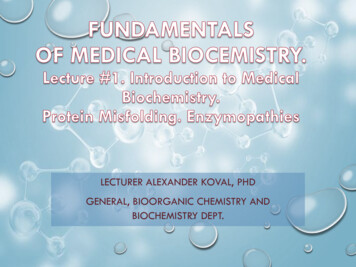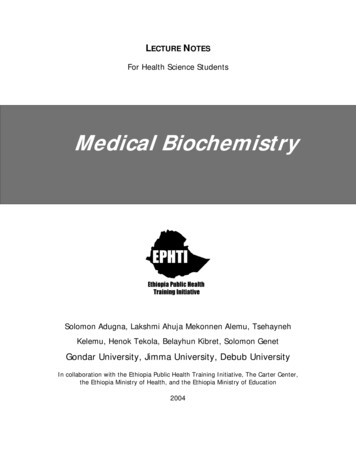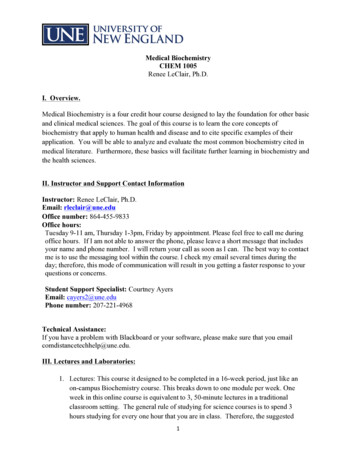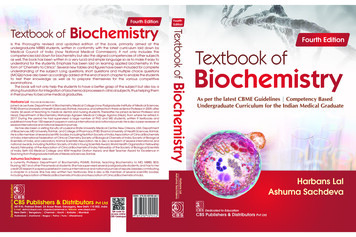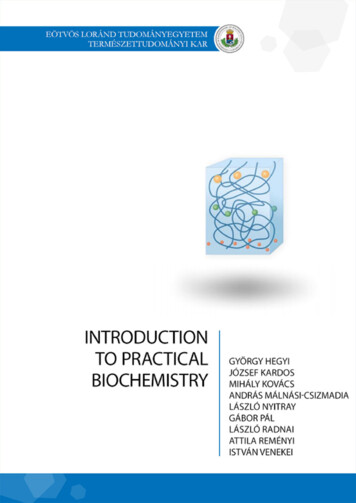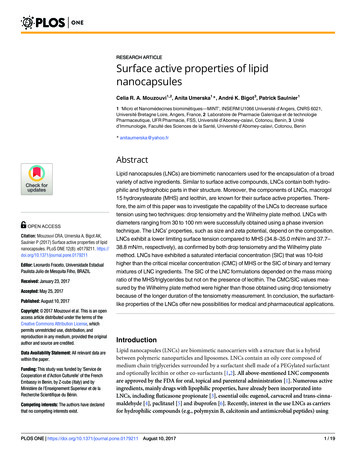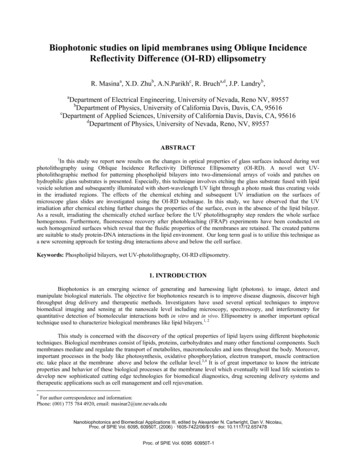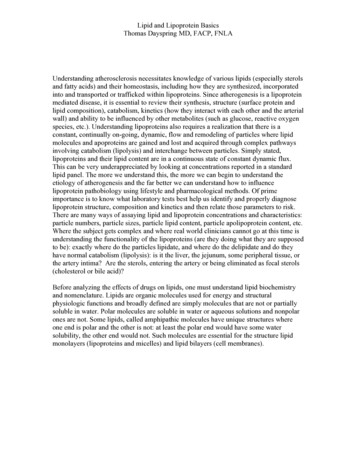
Transcription
Lipid and Lipoprotein BasicsThomas Dayspring MD, FACP, FNLAUnderstanding atherosclerosis necessitates knowledge of various lipids (especially sterolsand fatty acids) and their homeostasis, including how they are synthesized, incorporatedinto and transported or trafficked within lipoproteins. Since atherogenesis is a lipoproteinmediated disease, it is essential to review their synthesis, structure (surface protein andlipid composition), catabolism, kinetics (how they interact with each other and the arterialwall) and ability to be influenced by other metabolites (such as glucose, reactive oxygenspecies, etc.). Understanding lipoproteins also requires a realization that there is aconstant, continually on-going, dynamic, flow and remodeling of particles where lipidmolecules and apoproteins are gained and lost and acquired through complex pathwaysinvolving catabolism (lipolysis) and interchange between particles. Simply stated,lipoproteins and their lipid content are in a continuous state of constant dynamic flux.This can be very underappreciated by looking at concentrations reported in a standardlipid panel. The more we understand this, the more we can begin to understand theetiology of atherogenesis and the far better we can understand how to influencelipoprotein pathobiology using lifestyle and pharmacological methods. Of primeimportance is to know what laboratory tests best help us identify and properly diagnoselipoprotein structure, composition and kinetics and then relate those parameters to risk.There are many ways of assaying lipid and lipoprotein concentrations and characteristics:particle numbers, particle sizes, particle lipid content, particle apolipoprotein content, etc.Where the subject gets complex and where real world clinicians cannot go at this time isunderstanding the functionality of the lipoproteins (are they doing what they are supposedto be): exactly where do the particles lipidate, and where do the delipidate and do theyhave normal catabolism (lipolysis): is it the liver, the jejunum, some peripheral tissue, orthe artery intima? Are the sterols, entering the artery or being eliminated as fecal sterols(cholesterol or bile acid)?Before analyzing the effects of drugs on lipids, one must understand lipid biochemistryand nomenclature. Lipids are organic molecules used for energy and structuralphysiologic functions and broadly defined are simply molecules that are not or partiallysoluble in water. Polar molecules are soluble in water or aqueous solutions and nonpolarones are not. Some lipids, called amphipathic molecules have unique structures whereone end is polar and the other is not: at least the polar end would have some watersolubility, the other end would not. Such molecules are essential for the structure lipidmonolayers (lipoproteins and micelles) and lipid bilayers (cell membranes).
Lipid and Lipoprotein BasicsThomas Dayspring MD, FACP, FNLATG and PL are the major molecules in which fatty acids (FA) as well as phosphorus aredelivered to tissues. Plasma PL not found on lipoproteins are bound to phospholipidtransfer protein (PLTP) and plasma FA not found in PL or TG are bound to albumin andreferred to as free fatty acid or nonesterified fatty acids. TG molecules contain 3 FA andPL 2 FA per molecule.Sterols are divided into zoosterols (cholesterol and its precursors such as lathosterol ordesmosterol or metabolites such as cholestanol) and phytosterols (several exist, withsitosterol and campesterol being the most common). Any molecule that has a structurethat is very similar to cholesterol, but is not cholesterol is termed a noncholesterol sterol.A saturated sterol is called a stanol (there is a loss of the double bond at the Δ5 positionin the B ring. For example, sitosterol (a sterol) when reduced becomes sitostanol (astanol). UC has a –OH (hydroxy) group at the #3 position of the A ring, whereas CE hasthe –OH group replaced with a long chain fatty acid (typically palmitic or oleic acid).Cholesterol is esterified to cholesteryl palmitate or cholesterol oleate utilizing the enzymeacyl-cholesterol acyltransferase (ACAT). Unlike cholesterol, phytosterols are not a goodsubstrate for ACAT and are not readily esterified.
Lipid and Lipoprotein BasicsThomas Dayspring MD, FACP, FNLALipoproteins are simply protein enwrapped lipid transportation vehicles which acquire(lipidate) several lipids namely UC, CE, noncholesterol sterols, TG and PL and transportthem to and from various tissues. Biochemically speaking, lipoproteins are complexstructures consisting of a central core of nonpolar (hydrophobic) TG and CE surroundedby a one molecule thick monolayer where UC is interspaced with PL. Since both UC and
Lipid and Lipoprotein BasicsThomas Dayspring MD, FACP, FNLAPL are amphipathic molecules, that unique property allows their polar end to interact withthe water in plasma enhancing lipoprotein plasma solubility. The very hydrophobic CEand TG are relegated to the core of the particles away from the water in plasma and this isthe reason lipoproteins as they lipidate become spherical macromolecules. Thus everylipoprotein that exists has a one molecule surface layer of UC and PL and a core ofextremely variable amounts of CE and TG. Adding to the structure, stability andsolubility of lipoproteins are surface proteins (which to some extent also extend into theparticle core). By themselves these are called apoproteins but once attached to lipids,they are referred to as apolipoproteins. Therefore lipoproteins are protein wrapped lipidtransportation vehicles whose major function is just that: to traffic cholesterol (in theform of UC and CE), and fatty acids (in the form of PL and TG) in the plasma. HDLshave an added function of transporting numerous proteins (over 60 have been identified),many of which are immunomodulatory in function.Lipoproteins were first discovered and then named by separating them according to theirbuoyancy or density in a weak salt solution using the ultracentrifuge: chylomicrons arethe largest and most buoyant, followed by very low density (VLDL), intermediate density(IDL), low density (LDL) and high density (HDL) which is the smallest and densest. Thelargest particles (chylomicrons and VLDLs) have mostly TG in their core and theparticles carrying less TG are much smaller in size and denser in buoyancy. Largerlipoproteins are always buoyant compared to small lipoproteins which are comparativelyalways denser. It is therefore somewhat redundant to say large and buoyant or small anddense when describing lipoproteins. Thus the term small LDL should suffice rather than asmall, dense LDL. Lipoproteins are also classified according to their main structuralapoprotein. Thus the particles enwrapped by a single molecule of apolipoprotein B(apoB) are collectively called betalipoproteins which includes chylomicrons, VLDLs,
Lipid and Lipoprotein BasicsThomas Dayspring MD, FACP, FNLAIDLs and LDLs. Because there is one apoB molecule per particle, apoB is a lab assay thatcan be used to quantify apoB particles per deciliter of plasma. Those particles enwrappedby 1-4 (or even 5) molecules of apolipoprotein A-I (apoA-I) are the alphalipoproteins orHDLs. Because of the variable numbers of apoA-I molecules per particle, apoA-I is onlyan estimate of HDL particle concentration (HDL-P).Synthesis of chylomicron and VLDL begins with lipidation of apoB with UC, CE, PLand especially TG occurs primarily in the jejunum and liver respectively and then theseTG-rich particles are secreted into the lymphatic circulation (chylomicrons) and plasma(VLDLs). Although apoA-I is synthesized in hepatocytes and jejunal enterocytes, and issecreted and then lipidated in the plasma. Some apoA-I is also initially carried intoplasma on chylomicron surfaces. Delipidation of these TG-rich particles occurs in muscleand adipocyte vascular beds. The TG molecules are hydrolyzed by lipoprotein lipase (anenzyme upregulated in large part by insulin) to fatty acids and monoacylglycerols and theparticles shrink resulting in loss of large amounts of their surface PL. These smallerparticles carrying much less TG and PL still have their CE core: such particles are calledVLDL and chylomicron remnants. The particles which were formerly TG-rich are nowmuch less TG-rich and are trafficking primarily CE. The FA released from the TG canenter myocytes to be oxidized for energy or enter adipocytes and be reconverted to TG orbind to albumin and be trafficked elsewhere. The PL can be taken up by the cellmembranes or bind to phospholipid transfer proteins and carried to other cells or tomaturing (lipidating) HDL particles.Other than apoB and apoA-I, there are numerous other apolipoproteins which performmultiple functions. Some act as ligands that direct the lipoproteins to various cellmembrane receptors or endothelial surface molecules and some are involved with
Lipid and Lipoprotein BasicsThomas Dayspring MD, FACP, FNLAactivation or inactivation of various lipolytic enzymes such as lipoprotein lipase and otherenzymes. Many of the apoproteins exist as different genetically determined isoforms,which create individual and population differences in lipoprotein metabolism. Many ofthe apoproteins can be modulated by drugs in ways which might enhance or retard whatthe lipoprotein is doing.There is much confusion with lipoprotein terminology. For example LDL pattern A(larger LDL particle) has nothing to do with lipoprotein little a [Lp(a)] or lipoproteincapital A [LP:A]. LP:A is a lipoprotein with a member of the apoA family attached. Weknow of apoA-I, A-II, A-IV and A-V. ApoA has nothing to do with apo(a) or pattern ALDL. LP:A-I is an HDL carrying only apoA-I, but LP:A-I,A-II would be an HDLcarrying apoA-I and apoA-II. Likewise apoB is different than LDL pattern B (whichrefers to small LDL particles). Any lipoprotein that has apoB on its surface is termed abetalipoprotein and abbreviated as LP:B. Those with apoA-I are usuallyalphalipoproteins, but a chylomicron which is an apoB-containing particle also carriesapoA-I and could be referred to as LP:B,A-I. No HDL particle ever carries apoB andthus all HDL nomenclature starts with LP:A. If a beta-lipoprotein also carries apoC-III itis termed LP:B-C-III. An alpha-lipoprotein that has apoA-I, A-II, C-III, D on its surfaceis termed LP:A-I,A-II, C-III,D. A VLDL with apoB, apoA-II, apo, C-I,C-II, C-III andapoE would be LP:B,A-II,C-I,C-II,C-III,E. Since most LDLs only carry apoB and noother apoproteins, they are simply LP:BBETALIPOPROTEINS: Decades ago before anyone knew what an apoprotein was;particles were separated by their buoyancy in the ultracentrifuge. As electrophoresis cameinto play as a way to separate lipoproteins it was obvious that there was a particle verydifferent than the large TG-rich particles and since it migrated with beta-proteins it wascalled the beta (B) particle and it carried not TG but mostly cholesterol. Of course thisturned out to be the LDL particle and measuring it was and is called betaquantification.This was and unfortunately still is often considered by some as the standard ofquantitating LDL particles. Unfortunately betaquantification using the preparativeultracentrifuge to separate LDLs (and then measure their cholesterol) is extremely tediousand not available as a real world tool. As much as this is considered a religiousmeasurement betaquantification has never be used in a clinical outcome trial whereasother lab assays used to measure LDL, namely LDL-C, non-HDL-C, apoB and LDL-Phave. A long time ago betalipoproteins meant LDLs, but now the term is routinely usedto collectively refer to all of the apoB-containing particles.There are actually two types of apo B: either B48 (chylomicron or intestinal origin) orB100 (liver origin). ApoB48 has 48% of the molecular weight of apoB100 (it is atruncated apoB). The apoB containing lipoproteins are all potentially atherogenic becauseonce in the arterial intima, apoB adheres to arterial wall proteoglycans, where theparticles are susceptible to modification by reactive oxygen species and lipoproteinassociated phospholipase A2 (Lp-PLA2). Once modified, they are internalized bymacrophages, creating foam cells, the hallmark of atherosclerosis. ApoB100 is recognizedby the hepatic LDL receptor (LDLr) whereas apoB48 is not. Betalipoproteins can becollectively quantified by measuring apoB or individually quantified via nuclear
Lipid and Lipoprotein BasicsThomas Dayspring MD, FACP, FNLAmagnetic resonance spectroscopy (NMR LipoProfile performed by LipoScience).Directly measured apoB levels are a powerful measure of how many atherogeniclipoproteins are in a deciliter (dL) of plasma. Although one labs does it, apoB cannot becalculated (the formulas used to do so have never been published in peer reviewed labjournals). Because of apoB-particle half-life differences, 90% of measured apoBrepresents LDL-P (LDLs have an extended half life of 2-3 days unlike the very short halflife of chylomicrons, VLDL and IDLs).CHYLOMICRONS: large TG-rich lipoproteins formed in the intestine.Intestinally absorbed sterols and fatty acids are esterified and attached to apoB48 andform chylomicrons. More apolipoproteins are acquired during synthesis or as the particlestravel through the lymphatic system before or after entering the plasma (C-II, C-III, E andothers) from HDL. Chylomicrons rapidly undergo lipolysis (hydrolysis of triglyceridesinto fatty acids by lipoprotein lipase) and form smaller particles called chylomicronremnants. A protein crucial for chylomicron lipolysis by LPL isglycosylphosphatidylinositol-anchored high-density lipoprotein-binding protein 1(GPIHBP1).The remnants are internalized by hepatic LDL receptors (LDLr) and LDLreceptor related protein (LRP) using apoE as a ligand. A chylomicron half-life is lessthan an hour and most are gone in minutes. If chylomicrons are not rapidly cleared thepatient will have severe postprandial and fasting lipemia (hypertriglyceridemia).VLDLs (very low density lipoproteins) are synthesized in the liver. Theirdiameter varies from 40-200 nm, depending on their core lipid, especially TG, content. Inthe liver, TG and sterols (mostly cholesteryl ester) attach to apoB 100 utilizingmicrosomal triglyceride transfer protein (MTP). Ultimately they are phospholipidated in
Lipid and Lipoprotein BasicsThomas Dayspring MD, FACP, FNLAthe Golgi apparatus. VLDLs are rich in triglycerides and exactly how much TG theycontain determines their ultimate fate. Under normal physiologic conditions the TG/CEratio of VLDLs is 5 to 1. Labs therefore calculate VLDL-C by dividing TG by 5. EveryVLDL particle also contains a single molecule of apoB100. As they exit the liver andenter the plasma, VLDLs acquire apoA-V, apoC-I, C-II, C-III, apoE and otherapolipoproteins from HDLs. They can have several copies of these apoproteins. Note alsothat different VLDLs can have very different apoprotein content, especially apoC-III. Inhypertriglyceridemic states the liver produces increased quantities of VLDL particles andthey tend to be larger. Thus there is a correlation between TG and how many apoBparticles might exist. Large VLDL is also a marker of insulin resistance.Like chylomicrons VLDLs attach to LPL in muscular and adipocyte vascularendothelium. Binding to LPL is complex and highly regulated. ApoA-V attaches tovascular proteoglycans (in LPL enriched areas). ApoE binds to VLDL receptors whichare also expressed in these areas (different apoE isoforms have different bindingcapacities). ApoC-II is the actual ligand for LPL. Since chylomicrons are so much largerthan VLDLs and carry more apoC-II copies the chylomicrons get preferential lipolysis.Both apo C-I and apoC-III can retard the binding of apoC-II to LPL and thus delaylipolysis. It should be obvious that reduced LPL activity or reduced apoA-V, decreasedapoC-II, abnormal apoE and increase apoC-I and C-III are linked to delayed lipolysis ofTG-rich particles and hypertriglyceridemic states. Conversely enhancing LPL or raisingapoA-V or reducing apoC-I and apoC-III would reduce TG.Once a VLDL has lost enough of its core TG (and surface phospholipids) it will reduce insize, becoming a remnant and ultimately an IDL. In essence an IDL is a VLDL that haslost much of its core TG and some surface PL. In other words the mission (function) of a
Lipid and Lipoprotein BasicsThomas Dayspring MD, FACP, FNLAVLDL (and chylomicrons) is to traffic TG (energy in the form of FA) to muscle cells foruse or to adipocytes for storage as well as to deliver PL to cells. VLDLs do not delivercholesterol to the periphery: it gets passed onto their lipolytic end-product the IDLs.REMNANT LIPOPROTEINS: These are derivatives of the apoB containing TGrich VLDL or chylomicron particles, that have lost much of their core CE and surface PLand thus traffic mostly CE. Chylomicron remnants are cleared by the liver LDL receptorrelated receptor (LRP) or the LDLr: neither of those receptors recognize or bind to theapoB48 on the particle but use apoE instead. Any remnants not rapidly cleared can areatherogenic particles. Excess apoC-III can delay remnant clearance.IDLs (intermediate density lipoproteins) are the product of VLDL lipolysis(triglyceride hydrolysis or removal) or in some cases may be secreted directly from theliver. IDLs have variable composition depending on the internal ratio of CE to TG. Theyare usually transient (half-life of an hour or two) because once formed they rapidly bindto and are endocytosed by hepatic LDLr which binds to either apoB100 or apoE. Putanother way, apoB and apoE are ligands for the LDLr. Note that LDLr prefers the apoE3isoform. ApoE4 molecules are less readily recognized by LDLr. As IDLs enter hepaticsinusoids most bind to and are endocytosed into hepatocytes by LDLr. Howeverattachment to LDLr requires assistance from hepatic lipase (which has both triglyceridaseand phospholipase properties). So although most IDLs are internalized undergoadditional HL-mediated lipolysis and become LDL particles. As IDLs reduce in sizeapoE and any other surface apolipoproteins are lost and the subsequent LDL containsonly apoB. It is estimated only 30-40% of IDLs (“son of VLDL”) are transformed intoLDLs. Basically LDLs are the ultimate waste products of VLDLs.Typically IDLs, the lipolytic derivatives of VLDLs, are for the most part postprandiallipoproteins. In the lab it can be very difficult to distinguish between small VLDLs orlarger IDLs or small IDLs and large LDLs. Indeed since most labs do not separate outIDLs, LDL-C actually represents the cholesterol within all of the LDLs and IDLs thatexist in a deciliter of plasma: Reported LDL-C IDL-C actual LDL-C Lp(a)-C.
Lipid and Lipoprotein BasicsThomas Dayspring MD, FACP, FNLAIDLs can be very atherogenic if they linger in the circulation (the hallmark of rareFredrickson’s Type III dyslipoproteinemia). IDLs are ligands for hepatic lipase, which isthe enzyme involved in their catabolism. In a fasting state, in noninsulin resistantpatients, IDL particles may not be present at any meaningful concentration. Typicallythey are a postprandial lipoprotein. If present in excess concentration as in Type IIIdyslipoproteinemia (increased IDL-P), IDLs are very atherogenic. Under certainconditions LDL also may carry apoC-III and which impairs LDLr removal. In the CAREstudy LP:B,C-III was associated with very high risk.LDL: (low density lipoproteins) are the lipolytic product of IDL or small VLDLand a normally composed LDL contains a core of TG (20% or less), CE (80%) or a 4:1ratio of CE to TG. It is important to recognize that only some of the smaller VLDLs andIDLs become LDLs. In certain patients, potentially atherogenic noncholesterol sterols(i.e. sitosterol) may also be present within the apoB particles. Normal LDLs only containa single molecule of apoB and no other apolipoproteins. Without apoE, their hepaticclearance is much slower than that of IDLs and VLDLs. If apoC-III is on LDLs (LP:B,CIII) or apo(a) (LP:B,a) it can prevent binding to LDLr and delay LDL clearance. Anormal sized and composed (CE:TG 4.0) LDL particle typically carries around 2500molecules of CE in its core. Any LDL carrying less than that is said to be a cholesteroldepleted LDL and it always takes more CE-depleted than CE-rich LDLs to traffic a givencholesterol mass.The apoB molecule provides structure, stability and aqueous solubility to the LDLparticle but also serves as a ligand for the LDLr. There is a specific part (called the LDLreceptor binding domain) on the apoB molecule that is recognized by the LDLr. Persons
Lipid and Lipoprotein BasicsThomas Dayspring MD, FACP, FNLAwith abnormal domain structure which interferes with LDLr-mediated clearance havevery high apoB and LDL-C levels, a hypercholesterolemic condition called defectiveapoB.LDL particles are a heterogeneously sized group of particles ranging in size from large tosmall. Depending on the separation technique there can be as many as 15 different LDLspecies. In the two most commonly used techniques in clinical practice there are 7 LDLsizes reported by gel fractionation (Berkeley) and 2 reported by NMR spectroscopy(LipoScience). LDLs are grouped into two phenotypes: All people have a variety of LDLchanging particle sizes, but we all have a predominant LDL particle size which is calledLDL pattern or phenotype : Pattern A (large, buoyant) and Pattern B (small, dense). Inbetween sized particles were sometimes termed intermediate in size but that terminologyhas pretty much disappeared. When an LDL particle measures 20.5 or less nm via NMRtechnology), it is considered small, above that large.Since there is one apoB protein per LDL molecule, apoB measurements are anothertechnique to determine how many LDL particles are present: because of its much longerhalf-life the vast majority ( 90-95%) of apoB particles are LDLs. In actuality, except forunusual conditions (some very high TG states and Type III) at least 90% of measuredapoB is from LDL, due to LDLs long half life (3 days). ApoB is associated with risk atlevels 80-100 mg/dl. Ideal is less than 80 mg/dL or perhaps even 60 mg/dL in very highrisk patients. It is more accurate to measure LDL particle concentration (LDL-P) usingthe NMR (nuclear magnetic resonance spectroscopy) technique (n 1000 nmol/L). ForFramingham and MESA apoB and LDL-P population percentile cutpoints seehttp://www.lipidcenter.com/pdf/Framingham.pdf Remember LDL cholesterol (LDL-C)is simply the amount (mass) of cholesterol within all of the LDL particles per unit ofvolume (typically reported as mg/dL or in other countries mmol/L). LDL-C serves as asurrogate of apoB (mg/dL) or LDL-P (LDL particle concentration reported as nmol/L). Incertain patients both LDL-C and LDL-P correlate well and are said to be concordant withone another. Yet in others they do not correlate at all and are thus said to be discordant.In every study where discordance has occurred risk follows apoB or LDL-P, better thanLDL-C or non-HDL-C. Thus in several studies, including Framingham and MESA, LDLP is recognized as the best predictor of CV risk. LDL-P test is performed by LipoSciencein Raleigh, NC (www.liposcience.com) and is termed the NMR LipoProfile.It is crucial to have a clear understanding of how particle size contributes to atherogenesis(it does not). All LDL particles, large or small are atherogenic (will enter the arterialwall) if present in increased numbers (elevated LDL-P). If LDL-P is low (physiologic),there is little risk whether one has large or small LDL particles. Indeed, once LDL-P isknown, LDL size is no longer an independent risk factor for CHD. If LDL-P is high,CHD risk is high no matter whether the high LDL-P is driven by too many large LDLs,too many small LDLs or both. Keep in mind that the most lethal lipid/lipoprotein disorderis familial hypercholesterolemia. Such patients typically have very increased numbers ofthe larger (Pattern A) particles. All of the older studies that suggested risk is related tosmall LDLs per se, were never adjusted for LDL-P. Once that adjustment is made, therisk related to LDL size is no longer statistically significant.
Lipid and Lipoprotein BasicsThomas Dayspring MD, FACP, FNLABecause the volume of a sphere or circular particle is a third power of the radius (V 4/3π r3), there are considerable volume differences between particles that vary only slightlyin diameter. Thus if a patient has an LDL-C of 100 mg/dL it will take 40 to 70%(depending on the exact diameter) more small LDL than large LDL to carry the 100 mgof cholesterol. Therefore, even though an LDL-C may be 100 mg/dL, the LDL-P will be40-70% higher in patients with smaller rather than large LDL. Also if one has TG-richand thus cholesterol-poor LDL particles, it will take increased numbers of particles totraffic a given level of cholesterol. And it is LDL-P that primarily determines risk.To use a dump truck analogy: If I have a mountain of cholesterol to traffic, it will take farfewer large LDL dump trucks (earth-moving dump trucks) than it would small LDLdump trucks (pickup trucks). However, if the larger earth-moving dump trucks where50% full with something else (like TG), I’d need a lot more large of those dump trucksthan I would empty ones. So it is not the size but the volume available for CE thatmatters. That available LDL volume dedicated to CE is dependent on particle size,particle TG content or both.Since any apoB particle 70 nm in diameter can penetrate the vascular endothelium,LDL size does not influence LDL particle entry into the subintimal space (the largestLDL is 23 nm. Likewise the number of cholesterol molecules per particle has noinfluence on LDL particle entry. The only variables that affect vascular entry are LDL-Pand endothelial integrity. However, small particles carry lipoprotein-associatedphospholipase A2 (LP-PLA2) are quite prone to oxidative forces and are also less readilycleared by hepatic LDL receptors, which more easily recognize and attach to the apoB
Lipid and Lipoprotein BasicsThomas Dayspring MD, FACP, FNLAconformation on larger, normal-sized LDL. Thus almost all drug naïve patients withsmall LDLs have a very high LDL-P.The cholesterol in all of the beta lipoproteins (almost all of which are LDLs) is termednon-HDL-C and it is the best lipid concentration surrogate of atherogenic cholesterol andapoB levels. In effect non-HDL-C is the cholesterol that is not in the HDLs – therefore ithas to be in the apoB particles. It is calculated by subtracting HDL-C from totalcholesterol or by adding LDL-C plus VLDL-C. VLDL-C is calculated by TG/5. Inreality non HDL-C is the cholesterol in all of the LDLs (regardless of size), VLDLs,IDLs, chylomicrons, remnants and Lp(a) particles. LDLs typically make up 90-95% ofapoB particles and thus non-HDL-C is a better surrogate of apoB and LDL-P than isLDL-C. Non-HDL-C, like apoB or LDL-P does not require the patient to fast.Lp (a): Lipoprotein (a), called “lipoprotein little a,” is a beta-lipoprotein, namely alow density (LDL) particle that has apoprotein “a” attached to it. It is LP:B,a. Apo(a)comes in a high and low molecular weight (MW) isoform with the latter being moreassociated with CV risk. Similar to regular LDLs, risk for CHD related to Lp(a) is reallyrelated to LP(a) particle count or Lp(a)-P, of which no such test is available. The closetway to estimate Lp(a)-P at this time is to order an Lp(a)-C test. If high, it is likely thesmall or low MW isoform is present and Lp(a)-P is high. Thus a high apo(a) mass values[high Lp(a)] and a high Lp(a)-C signifies high Lp(a)-P. A high apo(a) mass and low orabsent Lp(a)-C signifies a low Lp(a)-P and no risk. This is typically seen in those withthe high MW isoform. Also note that in persons who have high Lp(a)-P, they also willhave several LDLs not carrying apo(a).
Lipid and Lipoprotein BasicsThomas Dayspring MD, FACP, FNLAStructurally apo(a) is homologous to plasminogen (a beneficial, fibrinolytic agent) but theapo(a) is not a functional plasminogen and it prevents the real plasminogen fromperforming its fibrinolytic functions. Thus Lp(a) is an LDL particle with a prothromboticaction (very undesirable). Apo(a) also serves as a sink (trafficker) of undesirable oxidizedlipids which further enhances its atherogenicity. Lp(a) is highly atherogenic in Caucasianand Asian (but often not in African American) peoples. This is an inherited lipoproteinabnormality and is either present or absent. If present, relatives should be screened.HDLs (high density lipoprotein) or lipoprotein A (LP:A) are alpha-lipoproteinsand traffic primarily cholesterol. Unlike the apoB particles HDLs are assembled in theplasma. The main surface apolipoprotein is two to four (or ? 5) molecules of apoA-Iwhich is regulated by PPAR-α and secreted by hepatocytes or enterocytes. ApoA-II isusually present with apoA-I on smaller, less mature HDL subspecies. A smaller HDL isLP:A-I,A-II. Historically the cholesterol in HDL has been considered not atherogenic, butthat is changing as cholesterol comes and goes into and out of HDLs as they areconstantly remodeled. This means HDLs are be transient carriers of UC and CE.Cholesterol in an HDL can easily wind up in an LDL very quickly. HDL is the smallestlipoprotein particle with multiple subtypes and sizes depending on the lab methodologyused. HDL particles are in a constant dynamic state of remodeling with on-goinglipidation and delipidation and acquisition and deacquisition of numerous proteins. HDLC is simply the cholesterol content (mass) being trafficked by all of the HDL particles ina deciliter of blood. The vast majority of the cholesterol mass is present in the two larger(mature) HDL species and persons lacking large HDL particles will have HDL-C values 40-45 mg/dL. However a person with high levels of smaller HDL species might havean HDL-C 40 mg/dL but have a normal or even high total HDL-P.
Lipid and Lipoprotein Basics Thomas Dayspring MD, FACP, FNLA Understanding atherosclerosis necessitates knowledge of various lipids (especially sterols and fatty acids) and their homeostasis, including how they are synthesized, incorporated into and transported or trafficked
